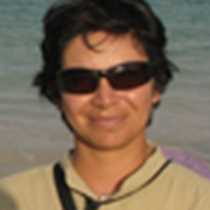Española Island
Last night we left North Seymour Island and headed towards the southeast. We had a smooth navigation and arrived to Española Island, where we spent our first full day in the Galápagos. This is the oldest island of the archipelago, and has the only colony of the extraordinary Galápagos waved albatross in the world.
We started right after breakfast and headed towards Punta Suarez, where we disembarked on a cemented dock. Upon landing we had to walk by a female Galápagos sea lion nursing her pup, neither of which even stopped to glance at us!
After this first close encounter, we came across lots of marine iguanas, which in Española happen to be the most colorful of seven subspecies in the islands. We also sighted many young finches, Española mockingbirds, Nazca boobies, and dozens of endemic Española lava lizards all over the place. We witnessed lots of activity among another endemic land bird, the Galápagos dove. Males followed females and after a short courtship display the couple mated and flew away, leaving us very surprised.
Far in the distance, we could hear the familiar thunder-like sound of the blow hole. We sat for a while to enjoy the sound and light breeze while a doubtful albatross could not decide whether or not to jump off the cliffs with such little breeze. We watched it for a while going back and forth several times; finally it sat down and looked towards the ocean with resignation.
We came back on board and geared up for snorkeling while we repositioned the ship to our next site, Gardner Bay. Here, we had several options for our afternoon outing: deep water snorkeling, Zodiac rides, kayaks or shallow water snorkeling lessons. We also got to enjoy relaxing beach walks, where we shared our time with hundreds of Galápagos sea lions and inquisitive mockingbirds.
We set off soon after dinner, on our way to Floreana Island where more exploration awaits. This was a great beginning to our week in Galápagos.
Last night we left North Seymour Island and headed towards the southeast. We had a smooth navigation and arrived to Española Island, where we spent our first full day in the Galápagos. This is the oldest island of the archipelago, and has the only colony of the extraordinary Galápagos waved albatross in the world.
We started right after breakfast and headed towards Punta Suarez, where we disembarked on a cemented dock. Upon landing we had to walk by a female Galápagos sea lion nursing her pup, neither of which even stopped to glance at us!
After this first close encounter, we came across lots of marine iguanas, which in Española happen to be the most colorful of seven subspecies in the islands. We also sighted many young finches, Española mockingbirds, Nazca boobies, and dozens of endemic Española lava lizards all over the place. We witnessed lots of activity among another endemic land bird, the Galápagos dove. Males followed females and after a short courtship display the couple mated and flew away, leaving us very surprised.
Far in the distance, we could hear the familiar thunder-like sound of the blow hole. We sat for a while to enjoy the sound and light breeze while a doubtful albatross could not decide whether or not to jump off the cliffs with such little breeze. We watched it for a while going back and forth several times; finally it sat down and looked towards the ocean with resignation.
We came back on board and geared up for snorkeling while we repositioned the ship to our next site, Gardner Bay. Here, we had several options for our afternoon outing: deep water snorkeling, Zodiac rides, kayaks or shallow water snorkeling lessons. We also got to enjoy relaxing beach walks, where we shared our time with hundreds of Galápagos sea lions and inquisitive mockingbirds.
We set off soon after dinner, on our way to Floreana Island where more exploration awaits. This was a great beginning to our week in Galápagos.



